“Battlegroup” WW2 Tactical Wargame Part One – Introduction & Overview
May 16, 2016 by crew
Beasts of War readers have certainly seen me (@oriskany) write plenty about World War II gaming, using a variety of systems. In this series, however, I’ve collaborated with community member @piers (Piers Brand) from Ironfist Publishing to highlight one system that I feel hasn’t received enough attention on Beasts of War: Battlegroup.
Presented by Ironfist Publishing and Plastic Soldier Company, Battlegroup is a tabletop minis game playable in just about any scale (commonly 15mm, 20mm, or 28mm). The game quickly made its mark, with “Battlegroup: Kursk” being nominated for Beast of War’s 2014 Best Historical Game. But what sets this system apart from its peers?
What's Different About Battlegroup?
While other World War II systems certainly have a healthy dose of historical flavour and detail, with Battlegroup such accuracy is baked into the core framework of the system. From the makeup of German panzer platoons to how an artillery fire mission actually works, history and tactical realism are more than flavour … they take centre stage.
In short, the kinds of methods, organizations, and tactics that worked on the battlefield are the ones that work best in Battlegroup, and not because the “rulebook says so.” The rules, rewards, and consequences are designed in an effort to replicate battlefield “physics” naturally, so the player is barely aware of them from a “gamey” point of view.
In this way, players that are familiar with World War II battles can try the tactics they’ve read about and tend to be rewarded when they work. German, Soviet, British, and American units are better at certain methods because their ratings reflect actual unit characteristics, as opposed to “turn to page 163 and invoke ‘X’ rule to get ‘Y’ result.”
Conversely, players less familiar World War II are free to experiment on their own. When they find something that works in the game, they may be surprised to find an account of an actual commander who did the same thing. The player has (vicariously) stood in that man’s boots and faced the same problem, and arrived at the same “answer.”
This isn’t to say that Battlegroup isn’t accessible or fun. Pretty much any miniatures of the chosen scale can be used. There are no restrictive rules on basing. The game is also scalable, where beginning players can get started with small squad or platoon-sized scrimmage games before moving up to company or even battalion.
Personally I prefer scenario-based play, based on historical research, that tries to replicate a given engagement on a given day. Battlegroup certainly supports this, but also presents a detailed and carefully-calculated point system that allows list-based army construction if players prefer a more tournament-style method of play.
To play Battlegroup, players need the core rulebook, a handy-sized 60-page resource perfect for quick reference at the table. However, players will also need at least one of the campaign supplements. These are larger hard-backed books, lavishly illustrated and packed with background, detail, army lists, painting guides, and scenarios.
These books also come with great reference sheets that can be carefully cut from the book, along with sheets of markers and counters (discussed in more detail later). With these references at hand, gamers will be able to play with a minimum of reference back to the books for important rules, lists, charts, and other information.
Other than that, the game requires very little in specialized components. Any six-sided dice will do, players won’t even need that many. Just about any 15mm or 20mm miniatures will work, along with terrain. Tables usually run about six feet, unless you’re playing a very large battalion-sized battle in 20mm, where eight feet might be better.
The Mechanics Of Battlegroup
The overall turn structure in Battlegroup is deceptively simple. Players start by rolling “Orders Dice,” usually 2d6, 3d6, or 4d6 depending on the size of their force and the number and quality of their officers. These “bell-curved” results dictate how many orders the player can issue to their force this turn.
There are about fifteen types of orders you can give, from basic movement and fire to resupplying heavy units with ammo or repairing (or towing) broken-down vehicles. You can call in artillery (depending on how important your little battle is in the grand scheme of things). Officers can rally pinned units, combat engineers can ply their trade.
You can also plan ahead for actions during your opponent’s turn by setting units on “Ambush Fire” or “Reserve Move.” In this way, it’s never strictly “the other guy’s turn,” you’re always engaged at the table and can inflict a surprising amount of damage during the opponent’s go, especially if you’re on defence.
One of the most unusual mechanics of the Battlegroup system is the use of “Battle Rating Counters.” To begin with, each side has a “battle rating,” a number which defines your force’s threshold for casualties, chaos, terror, and impatience with higher command. This is larger and better trained the force, the higher its battle rating.
Each time a unit is destroyed (a vehicle knocked out or an infantry team eliminated), you have to blindly draw a battle rating counter from a cup, box, or other handy container. Other factors can force you to draw a counter, such as coming under air attack, losing key officers or objectives, or being attacked with flamethrowers.
These counters usually have a number from 1 to 5 on them. This is the number of battle rating points your force has just lost. You put the counter face down on your side of the table, so your opponent can see how many counters you’ve had to draw, but not how many battle rating POINTS you’re actually down.
This means that you always have a vague idea of how badly you’ve hurt the enemy, but you’re never really sure how close he is to breaking. Sure, he may have a battle rating of 45 and he’s had to draw ten counters, but that could mean he’s barely been blooded, or that his men are about to put a bullet in their own commander.
I’ll admit this mechanic sounded a little random to me … until I tried it. In fact, the pool contains more “2” and “3” counters than “1s”, “4s”, and “5s”. This, plus the number of counters drawn in a typical game, results in a bell-shaped probability curve that stabilizes the game, with just the right amount of battlefield chaos.
Still, you never know what will happen, and this yields glorious gameplay. History is littered with heroic last stands – along with units that seemed to crumble straight away. One side will attack an objective, and come within an inch of taking it before failing, never realizing that their enemy was just a breath away from complete collapse.
Adding still more flavour, some counters have a special rule printed on them instead of a number. These do not affect your battle rating, but allow some special event to take place on the battlefield. A unit might go “Beyond the Call of Duty” or suffer a “Breakdown.” These add just enough cinematic chaos without making the game random.
Better still, which special counters are put into the mix at the game’s outset can be fine-tuned to reflect special conditions of the battle or the campaign. For example, if the battle is at night or bad weather, any “Airstrike” counters can be removed so both sides know that no one is getting any air support this battle.
When you army reaches its battle rating, you have lost the game. Your men have broken, your second-in-command just threatened to relieve you of command, or you’ve been ordered by HQ to break off the action. Frustrating? Sometimes. But this is how it happens, and Battlegroup strives for that realism.
More To Come!
Of course, we’re barely scratching the surface of this subtle, textured, and in some places almost deviously-designed wargame. We hope you’ll join us in the coming weeks for further explorations of Battlegroup, and post your comments and any questions you might have below.
Better yet, if we’ve piqued your interest, head over to the Plastic Soldier Company or Ironfist Publishing websites and see about giving this game a try. Or, if you’ve tried Battlegroup, tell us about your games!
By James Johnson & Piers Brand
If you have an article that you'd like to write for Beasts Of War then you con get in contact with us at [email protected] to find out more!
"While other World War II systems certainly have a healthy dose of historical flavour and detail, with Battlegroup such accuracy is baked into the core framework of the system..."
Supported by (Turn Off)
Supported by (Turn Off)
"One of the most unusual mechanics of the Battlegroup system is the use of “Battle Rating Counters"..."
Supported by (Turn Off)

































![How To Paint Moonstone’s Nanny | Goblin King Games [7 Days Early Access]](https://images.beastsofwar.com/2024/12/3CU-Gobin-King-Games-Moonstone-Shades-Nanny-coverimage-225-127.jpg)







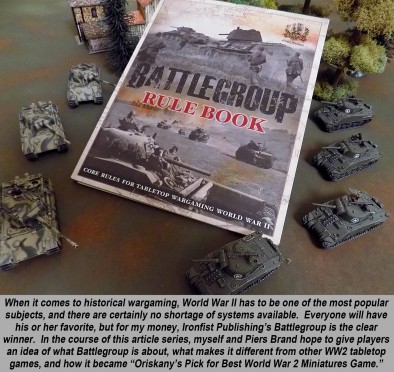
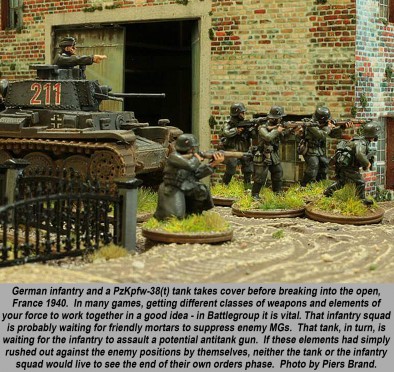
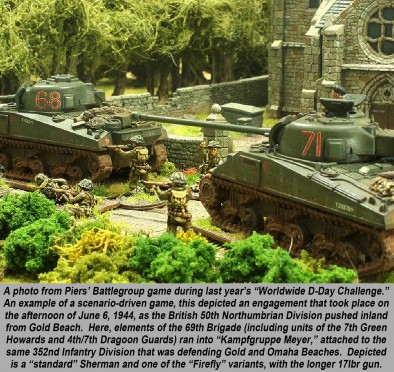
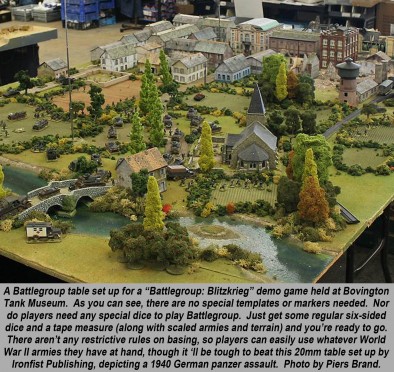
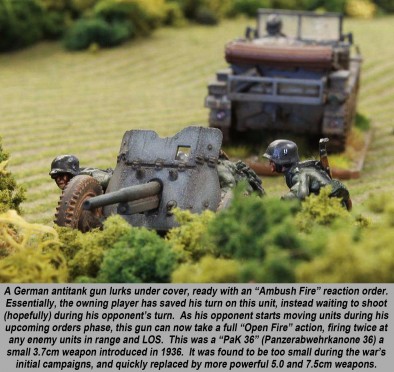
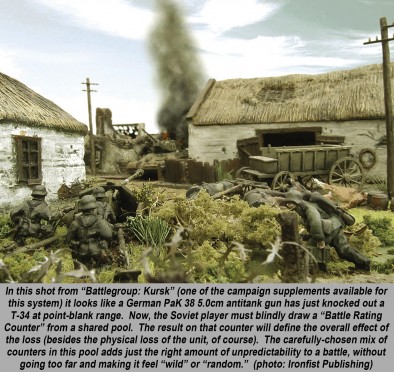
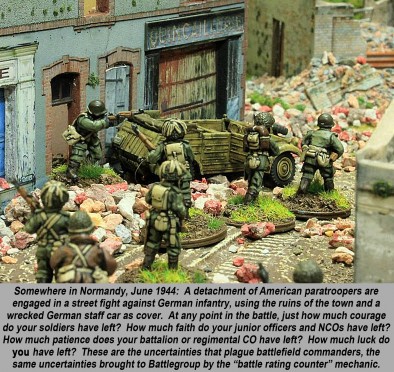
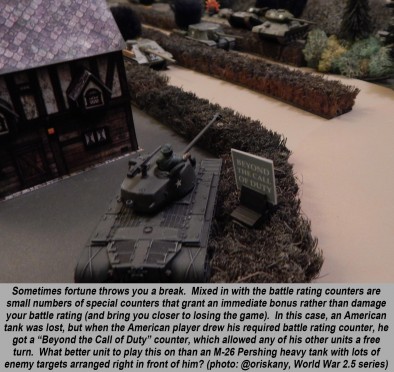
































Over on Twitter, @Chellicar has also set up a scenario from the latest book.
You can see his image here: https://twitter.com/CHellicar/status/732193265513037824
Thanks, @lancorz ~ I hope more people give this game a serious look, it really deserves more attention. And thanks 101 times to @piers for helping me out with this series and all the great photos!
I like what I see so far. I was concerned at first that the more “realistic” a wargame, the more book-keeping a player has to do between moments of actually moving soldiers around. However, I also like Battletech, so I shouldn’t complain about book-keeping.
With Bolt Action and Flames of War being so well supported, there are certainly plenty of miniatures choices to choose from.
The only issue I have is that there does not seem to be a “Vanilla” Battlegroup rulebook. And the physical book of Kursk is apparently sold out, but there is a PDF version available.
Thanks, @rfernandz2001 – As a quick aside, I’m just getting back into Battletech after a 25-year hiatus. 😀 I don’t think there’s that much more book keeping in Battlegroup than other games – pretty much just building your Battlegroup (i.e., army list) – but you have to do that in just about any game. Admittedly, in games with tanks, you usually track ammunition (not each and every shell, just “fire phases” worth of AP and HE ammo). But even this is just a tick mark on a sheet of paper, I haven’t found that it “takes away” from the game.… Read more »
Thanks! It’s an interesting take that “gameplay” is dependent on the campaign, as tactics, weapons, and units would evolve during the course of war.
Indeed, @rfernandz2001 – one of the great things about those campaign books (I have four of them myself) is that it doesn’t just list new vehicles / weapons that come out in different parts of the war. They also list the ways the units are put together. A Panzer Division of 1940, for example, is a very different beast than 1942, and not just because new re-equipment has come out. Probably the biggest example I’ve seen so far are the Soviets, between Barbarossa (1941), Kursk (1943) and Fall of the Reich (1945). The Red Army was smashed and rebuilt so… Read more »
“Finally, the campaign books sometimes have different random counters you can add to the mix – See more at: http://www.beastsofwar.com/battlegroup/part-one-introduction-overview/#comment-277842”
I only know of the alternate counters from BG: Fall of the Reich–and I have all the books released thus far. Are there some in the other books that I somehow overlooked?
Eh … you may be right, @iplay40k – the FotR ones were the ones I was looking at. My Barbarossa and Blitzkrieg books are at home (still at work, actually), I’ll have to check.
scratch that, there is a mini rulebook available at Plastic Soldier Company.
Yep, you need that small book, plus at least one of the campaign books, depending on what campaign your and your group might be most interested in. 😀
So ‘Ambush fire’ is kind of like ‘overwatch’ ?
It definitely sounds like something that is always a bit odd in FoW rules.
Thanks, @limburger – I’m not 100% on FoW, I’ve played a few very games and of course Team Yankee (which some would say isn’t really Flames of War). But at least in military parlance, “overwatch” is the element that holds its fire, but covers a given vector while a maneuver element (fireteam or squad or platoon) rushes forward. If the enemy responds to the maneuver element’s advance, the overwatch opens fire and suppresses the enemy fire, covering the maneuver element. Ambush fire doesn’t really work like that in Battlegroup. You’re simply designating a unit to hold their fire until the… Read more »
I’ve been reading the intro ‘battle report’ they’ve got :
http://ironfistpublishing.com/wp-content/uploads/2012/11/attachment_1415287810194_Intro_report.pdf
That illustrates the effect of both ‘ambush fire’ and the ‘area fire’ variant.
I can definitely see how FoW is more ‘game’ and Battlegroup is a simulation.
There’s nothing wrong with either approach.
@limburger – I’ve only combined Ambush Fire with Area fire on a few occasions. My favorite was when an MG team was on Ambush fire, and the opponent tried rushing across a crossroads. I took my Ambush Fire and pinned him in the open, within range for another SMG squad I had to do close assault.
Close Assault on a pinned enemy squad = a thing of beauty. 😀
(evil cackle)
http://ironfistpublishing.com/wp-content/uploads/2012/11/Dispatches-2.pdf
“pinned units can’t shoot back” …
That’s really evil, but realistic considering what ‘pinned’ means.
I guess I should have also specified, @limburger , that it was the opponent’s turn, he moved, I used Ambush Fire from my MG section’s last turn to pin him, THEN he rolled poorly on his rally phase 1d6 per BRC draw. Long story short, he just didn’t see my other SMG squad right there, or misjudged the distance. Either way, he didn’t unpin that squad in the crossroads. Of course, even if he had rallied at the end of his turn, that squad is still stuck there at the end of his turn. Now it’s my turn again, and… Read more »
+1 from me for Battlegroup. It is a very accessible game, not at all “old school”, pretty straightforward to play, yet still rewarding of “real world” tactics, rather than gamey ones. To that end I much prefer it to FoW, and even Bolt Action, although BA can still be a lot of fun. For instance you have finite tank ammo and have to plan carefully. Yet there isn’t too much bookkeeping – no more than most games where you need to keep track of wounds or morale and such. Maybe if we all shout loudly at the same time we’ll… Read more »
Thanks, @osbad – Yeah, Battlegroup is totally my pick, in case that wasn’t clear enough in the narrative and caption for the first image (“Oriskany’s Pick for Best WW2 Miniatures Game”). 😀 For tank ammo, you get a certain number of “fire phases” or “ammo shots” – which hard-core players then divide into HE and AP (so if a certain tank has Ammo 9 – a player may choose AP 6 and HE 3). Given that each type is practically (and realistically) useless against the targets usually engaged by the other, players have to face the real-world decision of how… Read more »
Well I’m just a drive away to be able to take a table up to them…
Your taking me with you…… Right!!!!! Please, pretty please
What about a comparative report? Play a historical action (anything really) in both FOW and Battlegroup formats and on the same scale – company or battalion. It would be interesting to see how the play and results compare.
I have the rules for both myself but have not got the time/space to try them out properly yet. I do like reading the books – lots of little gems in there that get you digging around in other sources to find out more.
Mister Piers is also a fabulous painter btw 🙂
@dorthonion – A company would work better, I think, only because a battalion-sized game in Battlegroup (while certainly possible and fun) – is a really big game. I think a big part of this is because a battalion in Battlegroup is the “right size,” i.e., freakin’ huge (3-4 complete simultaneous normally full-sized games) I could probably field a Soviet battalion … Americans maybe (LOOOOTs of T-34s and Shermans) – but anyone else would be a challenge. The Germans, maybe, because their battalions are often so badly understrength. 🙁 @piers is indeed the man when it comes to painting this stuff.… Read more »
You could say I’m half of Ironfist… but as there is only two of us it’s not as impressive as it sounds…
To be fair, Warwick Kinrade is the brains behind it. He does the lions share of the work and the pics. I just paint toy soldiers and write the odd book and bits… plus through in a few spanners now and then! 😉
Being a big fan of BA makes me wanting to use my minis, this could be another option.
Thanks – @maytresix . I honestly think Bolt Action is a fantastic infantry game, since the historical ranges of infantry battles in WW2 are so murderously short … and the large 28mm “true line of sight” scale of Bolt Action means the practical size of the average table will represent a relatively small piece of battlefield. Again, perfect for short-range infantry firefights. Early-war infantry were almost exclusively armed with bolt action (no pun intended 🙂 ) rifles like the Mauser K98, Mosin-Nagant, Springfield, and Enfield – meant to engage at ranges up to 500 yards (across 6-7 Bolt Action tables).… Read more »
I used the Sterling SMG in the British Army, which was a modern version of the sten. It was accurate up to 25m beyond that you may as well be throwing rocks. So I suspect the sten was no better, great for urban combat and close quarter but pretty useless for anything else.
As a side note the Sterling was used as the storm trooper gun in Star Wars.
As another aside…
The Sterling was derived from the Patchett SMG, a few of which went to Arnhem on their field trial…
I fired a Sten a few times. The phrase ‘street sweeper’ suits it. And never trust it’s safety…
Safety on a Sten? Remember the thing originally cost less than 3 pounds. 😉
Fantastic, I have been waiting for ages for this game to get some attention on BoW. I have the original Kampfgruppe Normandy rule book from Warhammer Historical that this game system origins stem from (I believe).
Cant wait for more ..!
Thanks very much, @vitor ! Glad you like the series so far, three more to go (plus maybe some battle reports in a forum thread). @piers also puts some battle reports in the forums. lately he’s bee showcasing some of his battles with the Wacht am Rhein (Battle of the Bulge) campaign book.
“These books also come with great reference sheets that can be carefully cut from the book”
Or, instead of cutting up your expensive book, you can just download and print the digital copies of the battlerating/moral counters and quick reference sheets on the Ironfirst Publishing website here: http://ironfistpublishing.com/?page_id=8 (plus they have other goodies there, such as the Dispatches, FAQs, etc.) =)
Yep… also a game play run through on the website to download too. Dispatches is our (very) irregular free fanzine with scenarios, lists and bits and bobs in it.
Reminds me… must start work on the third issue of Dispatches… got a Dutch list for 1940 that a few people want.
yay for Dutchies. 🙂
FoW already has one briefing :
http://www.flamesofwar.com/Portals/0/Documents/Briefings/Early-war/Netherlands-1940.pdf
It’ll be interesting to see how it compares.
Commission Figures do MDF markers for BG:
http://www.commission-figurines.co.uk/markers.html
Which is also an option.
Whoa, @y51c – these are sweet! I’ve been thinking of mounting one of my paper sets on old extra Scrabble tiles for a nice wooden set (also that way the paper ones don’t get bent up, etc). Might get these instead, especially the “FotR Black” ones or the Kursk tan ones. 😀
I have a set. They are much nicer than cardstock =)
Nice work as always @Oriskany the article looks great! The game did arise from the ashes of Kampfgruppe Normandy and we spent alot of time tweaking things and testing things. It’s been out a few years now and it’s great to see it being played in all scales and to see people enjoying it. We simply decided to do the game as we wanted to play it, each book is really just an accuse for us to play lots of games… but hopefully that love and enthusiasm for the hobby and history comes over in the books. As Oriskany states,… Read more »
Thanks very much, @piers – couldn’t have done it without the great photos (and of course proofing the drafts and making sure I wasn’t screwing up the rules).
I’ll confess there was at least one rule I was doing totally wrong until I started writing these articles. 🙁 Or more accurately, one rule I was never using because it didn’t seem worth it … because I didn’t understand it. 🙂
@oriskany Which rule did you have trouble with? @piers recently cleared up the ‘Unique’ special rule for me.
@iplay40k – I wasn’t getting the “Tactical Coordination Order” rule right (I think it’s called, again, my books are at home). Its the one where an officers can elect to draw a BRC to rally the pin marker off of one unit … BEFORE the rally phase (in other words, if you really NEED that one unit to activate this turn), rather than waiting until the Rally Phase when each BRC you draw can allow you rally 1d6 units. 😀
Ah, yes, “Tactical Coordination Order” is the correct name. It’s expensive (1 BR counter to remove the Pin condition from a single unit instead of 1 BR counter for 1d6 units during the Rally Phase…and your command unit cannot do anything…and it’s not even guaranteed to succeed since the nominated unit has to pass an experience test), but if you really, really need a unit unpinned now so it can receive an order this turn… I’ve never used it before (because I’ve never played with a Senior Officer in any of my Command units yet). It seems something you would… Read more »
@piers Think maybe you or Warwick could come up with some army lists/scenarios (either in a Dispatch or a Wacht am Rhein-type supplement for BG: Blitzkrieg) that cover the Soviet invasion of Poland, and the stuff that happens after the Invasion of Poland and before/during the Invasion of France (Soviet invasion of Finland, German invasions of Denmark and Norway)? It would be great if you guys could ‘fill in the gaps’ with some more BG: Blitzkrieg-related stuff.
We had a list for Soviets in 1939 but we had to drop it from Blitzkrieg as we ran out of space (same goes for the Norwegians and the FJ list).
Sadly our enthusiasms sometimes is limited by what we can economically fit in a book. But we will get to them sooner or later and likely for free.
@piers Hopefully sooner =)
Also, it would be great if you guys would put out some army lists and scenarios (or an actual supplement) for the Spanish Civil War since it happened right before the Invasion of Poland, and the Germans, Soviets, others were involved in supplying and testing vehicles and other equipment
I’m really looking forward to the North Africa and Italy books =)
Spanish Civil War is something id love to cover, both my stepfathers Grandfathers fought in it, and ideally in its own book.
But its a big undertaking as we’d be looking at doing armies and terrain with the book…
Well, I hope you will be able to do it…even if it is a few years down the road. I know the North Africa/Italy and Pacific books are more pressing, and I’m excited for them too.
I really want you guys to be able to cover the whole of WWII (as well as a other areas such as the Spanish Civil War). So you guys keep making BG books and supplements and I’ll keep buying them =)
Throw in the Dutch, Belgiums and Winter War Fins and it sounds like you could have enough for Blitzkrieg: Phony War soft cover or PDF at a later stage.
The two engagements that was the invasion of Denmark
I’ll confess, @iplay40k and @rasmus – I do have a friend on Beasts of War who found that that Battlegroup: Blitzkrieg didn’t include Winter War / Soviets vs. Finns material. There are Finns included in Barbarossa, for the 1941 “Continuation War,” although that’s not quite the same thing. Certainly not trying to talk ANYONE out of checking out any of the books, and certainly not hoping that Ironfist doesn’t keep making them. But once you get a baseline of two or three books, you can “triangulate” other campaigns on a limited basis if you really want to – i.e., World… Read more »
As a recent convert to Battlegroup (so far played 2 games) after 5+ years of FoW I am impressed with how quickly I picked up the rules (of which there are only a few basic concepts to get your head around) and the level of realism (as much as playing toy soldiers can be!). You are much less aware of playing a ‘game’ compared to FoW. When my lads took a tonking, it meant more – something intangible. Whereas with FoW it’s more about winning the game (irrespective what would happen on the turn after). The enjoyable part of Battlegroup… Read more »
Some would say a team of one and a half… 😉
North Africa underway… and Woz has been making LRDG trucks lately. Market-Garden is in discussion for the same treatment as Wacht am Rhein.
@grumpymoose – you write: “Whereas with FoW it’s more about winning the game (irrespective what would happen on the turn after).” – I totally know what you mean on this. A game scenario that ends on Turn 10 will always see people doing some seriously crazy s**t starting on around Turn 08 or so. And in all honesty, this happens in some of my other favorite games and even some games I’ve tried to design. Never a problem in Battlegroup, though, since you’re never really sure when the game will end thanks to the Battle Rating Counter system. This always… Read more »
Great looking game if/when I go WW2 (after the pirates I guess) that will be it …
Thanks, @rasmus . 😀
If I have to be a descenting opinion, Battle group is a good game but I have some issues with it. People like to play it in 15 mm and on individual bases it al looks “tiny” to me. It is fine if you want a skirmish but playing a company game with individually based 15 mm figures do not suite me. This also come to my second complaint, I feel the game really bogged down with book keeping in company and larger games with the “how fired the last turn and how much ap ammo do your panzer 4… Read more »
There is no specific basing requirement enforced in the books. You can have the figures on individual bases, multiple figures on the same base, or a mixture. Whatever works best for you and your group. Similarly, there is no specific figure scale requirement. You can used 15mm, 1/72, 28mm, or whatever scale works best for you and your group. You can use counters to keep track of which unit fired. If you’re playing really large games, and you find tracking the ammo cumbersome, you can always decide to not track ammo if you feel it’s burdensome. Whatever works best for… Read more »
Pardon me I was not particularly clear. I do not like to play large scale infantry forces( Company levels and above) were 1 model casualty removal is present in 15 mm scale. I would rather play with “elements” were perhaps a squad represents 1 element consisting of 2 bases of 5 infantry each. I feel that casualty’s can be abstracted away so that the element is in fighting form or it is destroyed. I could base my infantry on multi bases in battle group but then I would have to have counters for casualty’s( which is not a problem) but… Read more »
@rollsk1 and iplay40k – I will confess that in big battalion-scale games (i.e., 30 tanks per side), we only track ammo for tanks that have very low ammo storage (IS-series, the Sturmtiger with an Ammo of freakin’ ONE, etc). Also, when a “Low Ammo” counter is drawn and played.
Yer that works but we tend to have lots of players for big games so they track their own.
But part of my attraction to the system is it works at various size games. Single platoon games are some of my favourites and some of the historical scenarios feature less!
Most of my gaming is done with between 1 to 3 platoons and support generally. Bigger games we save for our event days.
Oo I am embarrassed to say I forgot to thank Mr Oriskany for the excellent article!^^
It will be great fun to read the next part.
I agree with @piers – any game over company size is usually not my thing, only because I tend not to have more than one opponent at a time. Battalion games I’ve done once or twice, but usually for a special occasion (i.e., the final “climactic” game for WW 2.5). That sumbitch took ALL DAY. Battalion play with team sounds like it would be a blast, though.
And thanks, @rollsk1 – glad you liked it! We have three more parts, one will be rolling out each Monday going forward. 😀
Ive tracked ammo using Smarties (basically M&Ms for those the other side of the pond). But chocolate based ammo counters lead to lots of pointless firing… when I got peckish.
We have some vehicle stat cards due out soon that should help.
To be fair to Mr Piers I have played around with a lot of ww2 rule sets from FOW , Rapid fire,Battle group, Bolt action, Chain of command and Iron cross because I try to find the right game for infantry combat for a company in the Crimea 1941-44. Inspired by “Where the iron crosses grow” By Rober Forczyk the best book about a military campaign I have ever read. The tactics describe is something I would like to recreate on the tabletop and so far Bolt action is the only game I can find that is “easy” enough and… Read more »
Im sold. I was looking to get into bolt action but i think this scratches my historic itch probably moreso!
@skiptotheend – I’ve heard Bolt Action described as a “WW2 Action Game” or a “WW2 Adventure Game” or even “WW2 Movie Game.” Absolutely nothing wrong with that, its just a different game that aims at a different objective. But if your “itch” is for history, Battlegroup might be a more viable alternative. Good news is that the miniatures can be used for both, so you can always change your mind with little loss of cash and hobby time. 😀
Someone, who pkays alot of WW2 rules, once described it to me that Bolt Action was the ‘Dirty Dozen’ or ‘Inglorious Bastards’ action movie version of WW2 rules, while Battlegroup was ‘Band of Brothers’.
That’s a great way of putting it, @piers . 😀
I’ve ordered the pdf rule book and kursk supplement. I wanted to try and find an in depth sniper style game for a stalingrad experience (after reading some memoirs from both sides). But I think this kind of has what i wanted but expands it out into squad combat etc. Also ordered some of those snazzy mdf markers.
Ive already got a couple of squads so I’ll start off small and see how it goes. I really like the idea of the tactical awareness, that one squad can’t trigger the action you want until other units have been supressed etc.
Awesome, @skiptotheend – Kursk is the first campaign book they produced, and still one of the best IMHO. Then again, it may be because Kursk is one of my favorite battles. 😀 They have a great campaign section detailing specifically with titanic tank clash at Prokhorovka, Paul Hausser’s 2nd SS Panzer Corps vs. Rotmistrov’s 5th Guards Tank Army. It sounds like smaller infantry squads are more up your alley at least for now, but despite all the press that tanks get at Kursk, the majority of the battle was fought (as is always) by the “poor bloody infantry.” A squad… Read more »
Let me know what you think of Blitzkrieg @Oriskany
Alot of my blood, sweat, tears and strife went into that one. 🙂
Definitely like it so far, @piers . And I see where you got “first billing.” 😀 Again, I’ve barely had time to flip through it so far, but I already see all these army lists, more than just two. Poles, French, British, Belgians, and Germans of course. Great!
great article, thanks guys!
my 15 mm US paratrooper force is about to be finished, I could give BG a try with them. Also I still have two sets of allied tanks from the FoW open fire box, which are waiting to be built and put into action. Maybe in the future there will be a BG FOW series….
edit:
BG FOW = BG FTW
That would be awesome. I would totally get on a plane and fly over to BoW HQ to help film that series … with just a month or two of warning. 😀
Now between you and @piers who can turn that down ?
Im game as long as @oriskany comes for a few games at mine too…
He will have to avoid the five year old ninja that lives with me though.
Wouldn’t mind making a tour of it. 😀
a great article with a very interesting game.
Nice write up James
Although not aimed at a level I prefer gaming at I have heard good things about the game
I gave found these useful and although aimed at s smaller skirmish level they are easy to scale up and there are some free downloads as well
http://www.skirmishcampaigns.com/books.htm
Thanks @zorg and @torros – I’ll h ave to check out those downloads when I get a chance. 😀
And hey, Rasmus, you never know. Piers, me, John Lyons and Justin around a table in “the BoW Cage?” Stranger things have happened. 😀
Or a BG bootcamp? One can always dream ; )
Hey, if we get enough people together, you never know! 😀 The great thing is that everyone can use their own pre-existing miniatures. I prefer 15mm or even 10mm. The smaller the scale the better for more realistic relationships between the units and the terrain, at least on my humble 6 x 4 tables. Bigger tables like 8 x 4 or 8 x 6 can easily accommodate 20mm figures.
I’m actually planning one in Ireland hosted by me and Woz…
Would these rules be suitable to play the Korean War with. I’m currently putting together a Chinese, US and British armies in 20mm for a campaign set in the Korean conflict.
Funnily enough I was thinking the same thing…
Just use the British and US lists from Fall of the Reich against the Russian one, picking out the right vehicles. You’d want some way to reflect the nature of Chinese and North Korean troops but ai may have something that might help with that.
Would work fine for Korea. We’ve been testing a Cold War variant too so it will fit Korea very well. Just some stats for a Centurion are needed…
@warhammergrimace- used Battlegroup: Fall of the Reich for World War 2.5 (1946) – not quite the same thing, but managed it very close. As @piers says, some stats are required for vehicles like the Centurion, which we extrapolated from stats for the 6-pounder, 17-pounder, and then took the next step with the 20-pounder (84mm I think) mounted on early Centurions, using guns like the late war German L70/71 88mm and US 90mm as a guide as well.
The beauty of historical gaming. You invest your hobby time and money in the periods that capture your interest. Another rule set grabs your attention, it’s no problem you already have the mini’s, the terrain and more than likely a group of like minded friends.
Couldn’t have said it better myself, @huscarle . 😀
Great article @oriskany
I have the mini rules PDF for the game, read it and must say it seems complex after the first read. I did not have a chance to play it yet thou.
Thanks, @yavasa . 😀 Is Battlegroup complex? Ehh … possibly? I’ve always believed that whether a game seems complex is partially dependent on the complexity of the last game the player enjoyed. 😀 Just going by the core rulebook, Battlegroup can seem complex for two reasons: 1) That’s only “half the game.” Without at least one of the campaign supplement books to plug into, the core rules can seem isolated, with a lot of loose ends that don’t form into a cohesive whole. 2) The core rulebook overviews all the available mechanics. I have yet to play a single game… Read more »
The star cards for vehicles are very cool… Vehicle and gun data on a handy card… just pull out one for each vehicle and away you go. It’s something we wanted to do for ages but they take a hell of a lot of time to do… and also sapped Woz’s sanity big time. But all done now just waiting to see how best to get them printed up… With those and the QRS you won’t really need to look in a book… As for complexity… I find every set of rules complex when I first pick it up, and… Read more »
@oriskany and @piers 🙂
Please don’t get the wrong impression from my post 🙂 I really did not have a chance to play Battlegroup so what I am only trying to say that the rules do look complex after the first read. I am definitely giving the a go soon. I just need to order one of the supplements. This article and @piers ‘ painting on the WAYPN thread really push me towards the game. Still, I need to finish painting my Germans (and stop playing with friend’s army :P) thou.
No worries at all @yavasa – I was just agreeing that the game looked a little “charty” to me when I first picked it up, others have said so, and also before i played it it seemed like the BRC, orders dice, 1d6 units / BRC on a rally check, special BRC counters, and other aspects made the game seem a little random … until I tried it. I just don’t want players to feel (and this might be one of the hurdles BG faces in general) that it’s too weighty, complex, or random before they give it a go.… Read more »
Excellent article as we’ve come to expect 😉
I’m glad my gaming group has finally embraced ww2 wargaming, I’ll get them into BG in no time! 😀
Hey, look who it is, @neves1789 . A veteran of the WWDDC. 😀 I sooooooo wanted to use Battlegroup to do my games in the WWDDC, but the players I had in my group at the time were not yet familiar with the system. Also I didn’t have BG: Overlord. 😀
Man, BG Overlord has been sitting on my shelf since Salute three years ago! I’m gonna make it happen next month! 😀
Awesome, @neves1789 . 🙂 I have a game of Battlegroup Barbarossa lined up for later today. Spent yesterday afternoon setting up a 6×4 table.
Great article, looking forward to seeing the rest, and glad to see BG get some coverage it rightly deserves.
Thanks, @y51c . I didn’t think too many people liked or played this game, but this comment thread has certainly proved me wrong on that account! 😀
I think it helps if someone can explain why the system works as it does.
The Battlegroup books themselves felt primitive when compared to the flashier FoW supplements.
Articles like this series help sell systems to those wondering why the heck you’d even want to consider getting into this hobby.
Primitive in what way?
Just wondering as Woz did the old Imperial Armour books for Forgeworld and used that experience for Battlegroup.
Im honestly curious as its not an opinion we have come across since we released the books, with most commenting how well they look, so its interesting to hear different.
Here is an example page spread from Blitzkrieg…
http://2.bp.blogspot.com/-9C1kY0U2s9s/VNJADtQD7YI/AAAAAAAAoQE/fD4DllSOYb4/s1600/10960133_725812334193536_6507533721226734507_o.jpg
@piers and @limburger – Funny this should come up, JUST TODAY I finally got my copy of Battlegroup: Blitzkrieg to add to my collection. I’ve always though the Battlegroup campaign books looked amazing. The only “FoW” book I have is the Team Yankee book (again, I know not everyone will consider that a true FoW Book), and both have great production value, but the Battlegroup campaign books are larger, have more photos, charts, and maps, and definitely more (and more accurate) background information. Also, in the core rulebook, space is devoted explaining why different rules work the way they do.… Read more »
@piers : I’d say compared to how flashy the likes of Battlefront and Gamesworkshop promote and present their products in stores.
It kind of looked like a deeply serious and potentially boring text book and less like a fun game.
@limburger
Fair enough mate… I shall respectfully disagree. 🙂
I like pics of figures, art and period photos in books. For us it sets the tone of the game. If my text books had looked like our books I may have done better at school!
I’d also suggest that FoW and GW have a slightly larger promotional budget than two blokes… 😉
@piers :
It was just a first impression I got though.
And I think I can honestly say that this article has made me see I was wrong for letting my first impression stop me.
@limburger No worries dude… Good to hear opinions like that, helps us consider things. We’d honestly love to be able to have a better promotional drive, but we work on limited resources (generally powered by cider and curry). All our resources, both in terms of time and finances, go into the books. Each book funds the next so to speak. We’d love to get to more shows and stores, especially in Europe but with a ‘real’ job and a family and having to pay for it ourselves, it doesn’t happen as often as we’d like. One day we might get… Read more »
I couldn’t disagree more that they’re ‘primitive’. The books are gorgeously produced.
The game is pretty damn good as well, especially the Fall of the Reich supplement which models the degraded yet still dangerous capabilities of the German forces of 1945 in a way I’ve not seen anywhere else.
Fall of the Reich is my favourite along with Blitzkrieg… we enjoyed doing that one… 🙂
My Volkssturm may not win much, but when they do, you can be sure I will go on about it for months!
Excellent article. Having thought that the game looked very complex, all of @oriskany‘s brainwashing, er – I mean articles – have made me think again, and I picked up the rulebook and Blitzkreig book at Salute last year. Although haven’t got round to reading them yet, sadly… Is it right that all the counters can be downloaded for free? It seems a shame to cut up a book. Also, could you say a bit more about how the game scales? How do larger games play without bogging down? Or is the answer just to have multiple players per side?
@angelicdespot – Brainwashing? (twirls evil mustache) “Mwah-ha-ha-ha … Whatever do you mean?” Okay, first up … the counters can be found on the Ironfist Publishing site. Just follow this link, find the “Downloads” menu, and you come to a page with counters, plus counters for Fall of the Reich, Quick Reference Sheets, the works. http://ironfistpublishing.com/ Piers might be better to talk in detail about how the game scales up from squad to platoon to company to battalion. All my games have been platoon or company, I prefer anywhere from 2-4 platoons (so usually a company, I guess). I’ve done battalion… Read more »
All wargames slow down as you add more units… it’s a nature of the beast. I’ve run several ‘big games’ with Battlegroup. Usually between 6 to 10 players a side. The key is to split each players command so he controls a normal sized army. I’m running a game this year based on the assault on Langerwehe with seven players aside. The real action was a reinforced company assault and we are recreating that at 1 – 1 scaling. Each player will have around a platoon of troops plus additional supporting elements while one will act as C in C… Read more »
How did this actually work? I mean, did each player have like 1d6 orders or something like that? And then the CnC player had what, an extra 2d6 or 3d6 or something. And then each turn, the CnC would give those dice out in some fashion? I’m just curious as to how this works, actually.
@piers “Each player will have around a platoon of troops plus additional supporting elements while one will act as C in C issuing bonus command dice and controlling artillery assets.”
For our big games each player essentially has a small army each to command. They generally get one die for orders or two depending on the size we are playing at. To take the coming Langerwehe refight later this year, each side consists of six players. Each will have 1d6 for orders. Each sides CO will have his own die plus four bonus dice for Yanks and three bonus dice for Germans. The COs can ‘issue’ these dice as they see fit to subordinate platoon commanders or keep them to use for their artillery support. Each die has to be… Read more »
Sounds like a fun time =)
Six players on a side? Damn, that sounds like an awesome game. I can only imagine how epic that is. Shit, and you even have “COs” or “team captains.”
Only played one game like this, must’ve been 1,000 years ago, three players per side plus a CO, Gettysburg, ACW. I played Longstreet, with two Confederate Teammates playing Ewell and AP Hill with the team captain of course playing Lee. Great memories.
I would love to do something like this in Battlegroup, but I’m hard-pressed to find ONE player, never mind 12. 🙁
Well our US C-in-C is flying over from Arlington to be at the game…